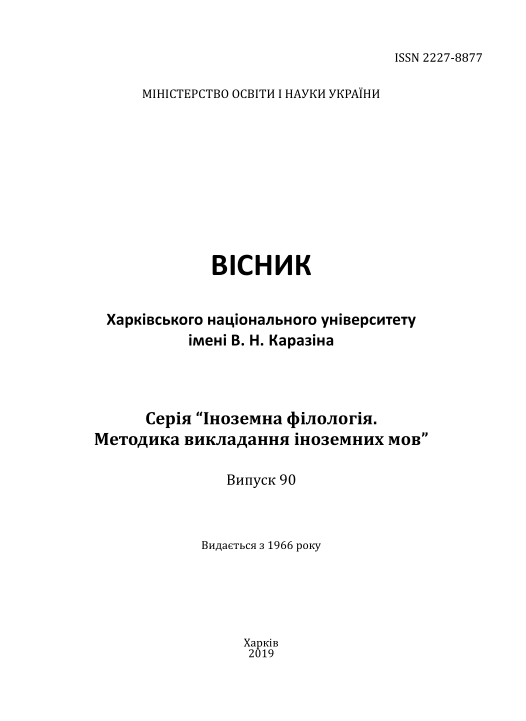Discursive environment as a medium for the social roles realization
Abstract
The article is focused on the study of the speech realization of social roles in the nuclear, marginal and peripheral zones of the speaker’s discursive environment through verbal and non-verbal communicative components. The speaker, who is in the focus of this research, performs certain social roles in interaction with other people. This kind of focus puts this work on the one stage with the latest human-centric research. The discursive interpretation of anthropocentrism is motivated by the need to fix communicative structures and operations that presuppose communicatively successful parties of a discursive personality. The social roles realization is reflected in linguistic and pragmatic features, namely, in the variability of verbal and non-verbal communicative components. The research material – dialogical discursive fragments displaying the change of roles configurations – allows to identify and describe the epistemological basis of successful communicative interaction. Discourse and linguopragmatic research tools help to establish the verbal and non-verbal communicative components used by the individual in different discursive environments and conditions for successful communication according to the type of discursive environment and the distancing level of stance-subjects. The article grounds the interconnection between the social role and stance-taking, thus, explaining the potential of the discursive environment as a medium for the social roles realization.
Downloads
References
Zvyeryeva, O.G. (2014). Komunikatyvni strategiyi siblingiv v anglomovnomu simejnomu dyskursi. Avtoref. dys. kand. filol. nauk [Communicative strategies of siblings in English family discourse. Cand. philol. sci. diss. synopsis]. Kharkiv (in Ukrainian)
Issers, O.S. (2003). Kommunikativnye strategii i taktiki russkoj rechi [Communicative strategies and tactics of the Russian language]. Moscow.
Karasik, V.I. (2002). Yazyk social'nogo statusa [Language of social status]. Moscow: Gnozis.
Larina, T.V. (2009). Kategoriya vezhlivosti i stil’ kommunikacii [Politeness category and the style of communication]. Moscow.
Pasternak, T.A. (2013). Problema rol`ovoyi dyferenciaciyi komunikantiv u suchasnykh dyskursyvnykh doslidzhennyakh [Problem of communicants’ role differentiation in modern discourse studies]. Visnyk Kharkiv. nats. un-tu im. V.N. Karazina. – V.N. Karazin Kharkiv. National Univ. Messenger, 1052, 21–25. (in Ukrainian)
Sedov, K.F. (2004). Diskurs i lichnost’: jevoluciya kommunikativnoj kompetencii [Discourse and personality: evolution of communicative competence]. Moscow.
Soloshhuk, L.V. (2009). Vzayemodiya verbal`nykh i neverbal`nykh komponentiv komunikaciyi u suchasnomu anglomovnomu dyskursi. Avtoref. dys. kand. filol. nauk [Interaction of verbal and non-verbal components of communication in modern English discourse. Dr. philol. sci. diss. synopsis]. Kyiv (in Ukrainian)
Soloshhuk, L.V. (2015). Dyskursyvna osobystist` u svitli teoriyi polikodovosti komunikatyvnogo procesu [The discursive personality within the frames of the theory of policode nature of the communicative process]. Zapysky z romano-germans`koyi filologiyi. Odes`k. nacz. un-t imeni I. I. Mechnykova. – Notes on Roman-German philology of I. I. Mechnykov Odessa national university, 1(34), 160–167. (in Ukrainian)
Suhih, S.A. (2004). Lichnost’ v kommunikativnom processe [Personality in the communicative process]. Krasnodar.
Tovstenyuk, K.V. (2011). Psyhologichna dystanciya u komunikatyvnomu prostori spivrozmovnyka [Psychological distance in the speaker’s communicative space]. Naukovyj visnyk Volyns`kogo nacz. un-tu imeni Lesi Ukrayinky. Seriya «Filologichni nauky. Movoznavstvo». Lucz`k, 4, 101–105. (in Ukrainian)
Uschina, V.A. (2015). Pozytsionuvannya subyektu v anhlomovnomu dyskursi ryzyku: sotsiokohnityvnyj aspekt [Stancetaking in the English discourse on risk: sociocognitive aspect]. Lutsk: Vezha-Druk.
Frolova, I.Ye. (2015). Rehulyatyvnyj potentsial stratehiyi konfrontatsiyi v anhlomovnomu dyskursi. Avtoref. dys. dokt. filol. nauk [Regulative potential of the confrontation strategy in English discourse. Dr. philol. sci. diss. synopsis]. Kharkiv (in Ukrainian)
Yakubinskij, L.P. (1986). Izbrannye raboty: yazyk i ego funkcionirovanie [Selected works: Language and its functioning]. Moscow.
Bell, R. (1976). Sociolinguistics – goals, approaches and problems. London: Batsford.
Bergelson, M. Understanding Russians: context of intercultural communication. URL : https://coursera.org (28.04.2019).
Berne, E. (2016). Games People Play. The Psychology of Human Relationships. London: Penguin Life.
Brown, P., Levinson, S. (2013). Politeness: some universals in language usage. Cambridge: Cambridge University Press.
Fairclough, N. (1995). Critical discourse analysis: the critical study of language. London: Longman.
Lakoff, G. (1987). Women, fire and dangerous things: What categories reveal about the mind. Chicago-London: The University of Chicago Press.
Levinson, S. (1983). Pragmatics. Cambridge.
Pamuk, O. (2009). The Museum Of Innocence. Knopf.
Skrynnik, J. (2019). Variativity of a speaker’s verbal and non-verbal behavior in English business discourse. In: E. Bernardez, J. Jablonska-Hood, K. Stadnyk (eds.). Cognition in context. New insights into language, culture and the mind. Berlin: Peter Lang GmbH Internationaler Verlag der Wissenschaften. Vol. 64, pp. 153–161.
Wierzbicka, A. (1991). Cross-Cultural Pragmatics. The Semantics of Human Interaction. Berlin & New York.




